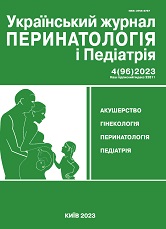The effect of hydrogel dressing on the process of episiotomy wound healing
DOI:
https://doi.org/10.15574/PP.2023.96.57Keywords:
episiotomy wound, healing, REEDA, postpartum periodAbstract
Childbirth is an event that affects the mother both physically and emotionally in the short and long term. About a third of women give birth physiologically, but the rest undergo interventions. One of the most common interventions during birth is the use of an episiotomy, which is the surgical widening of the vaginal opening through an incision in the perineum during the second stage of labor. Accordingly, after the incision, there is a need to create favorable conditions for better healing and restoration of the episiotomy wound.
Purpose - to study the effectiveness of hydrogel dressings with lidocaine in the management of episiotomy wounds.
Materials and methods. The prospective randomised study analysed clinical, laboratory and anamnestic data of 123 first-time mothers with episiotic wounds (Kyiv City Maternity Hospital No. 5, 2021-2022). Participants were divided into two groups: a comparison group (63 patients), which received standard treatment; a study group (60 patients), which additionally received hydrogel dressings with lidocaine. Wound healing was assessed by the REEDA scale on the 1st, 2nd, 3rd and 10th day after delivery. Statistical analysis was performed using the Mann-Whitney test and the statistical package EZR v. 1.54.
Results. The results of the analysis of the total values according to the REEDA scale showed that the process of episiotic wound healing between the two groups of patients proceeded similarly on the 1st day of observation (5 (3.25-6) points - in the comparison group; 4 (3-6) points - in the study group; p=0.589). At the end of the 2nd day of follow-up, the results indicated a statistically significant difference (7 (6-8) points in the comparison group, 6 (4-7.5) points in the study group; p=0.001). The analysis of the sum of points at the end of the 3rd and 10th days of observation showed statistically significant differences (6 (5-7) and 4 (4-5) - in the comparison group (p=0.014); 6 (3-6.5) and 3 (3-4) - in the study group (p<0.001), respectively).
Conclusions. The use of hydrogel dressing with lidocaine in the management of the episiotomy wound reduces the scores according to the REEDA scale on the 2nd, 3rd and 10th days after delivery, which indicates a more effective episiotomy healing process compared to patients with a comparison group. Hydrogel dressing with lidocaine contribute to better healing of episiotomy wounds, proving their usefulness in clinical practice.
The research was carried out in accordance with the principles of the Helsinki Declaration. The study protocol was approved by the Local Ethics Committee of the participating institution. The informed consent of the patient was obtained for conducting the studies.
No conflict of interests was declared by the authors.
References
Carroli G, Belizan J. (1999). Episiotomy for vaginal birth. Cochrane database of systematic reviews: 3. https://doi.org/10.1002/14651858.CD000081
Conover WJ. (1999). Practical nonparametric statistics. John wiley & sons.
Davidson N. (1974). REEDA: evaluating postpartum healing. Journal of Nurse‐Midwifery. 19 (2): 6-8.
Golezar S. (2016). Ananas comosus effect on perineal pain and wound healing after episiotomy: a randomized double-blind placebo-controlled clinical trial. Iranian Red Crescent Medical Journal. 18: 3. https://doi.org/10.5812/ircmj.21019; PMid:27247780 PMCid:PMC4884440
Graham ID, Carroli G, Davies C, Medves JM. (2005). Episiotomy rates around the world: an update. Birth. 32 (3): 219-223. https://doi.org/10.1111/j.0730-7659.2005.00373.x; PMid:16128977
Hadizadeh-Talasaz F, Mardani F, Bahri N, Rakhshandeh H, Khajavian N, Taghieh M. (2022). Effect of Rosemary Cream on Episiotomy Wound Healing in Primiparous Women: A Randomized Clinical Trial. BMC Complementary Medicine and Therapies. 22 (1): 1-10. https://doi.org/10.1186/s12906-022-03675-1; PMid:36028878 PMCid:PMC9413876
National Collaborating Centre for Women's and Children's Health (UK). (2014). Intrapartum care: care of healthy women and their babies during childbirth. London: National Institute for Health and Care Excellence.
Prosser SJ, Barnett AG, Miller YD. (2018). Factors promoting or inhibiting normal birth. BMC pregnancy and childbirth. 18 (1): 1-10. https://doi.org/10.1186/s12884-018-1871-5; PMid:29914395 PMCid:PMC6006773
Toomari E, Hajian S, Mojab F, Omidkhah T, Nasiri M. (2021). Evaluation the effect of Silybum marianum ointment on episiotomy wound healing and pain intensity in primiparous women: a randomized triple blind clinical trial. BMC complementary medicine and therapies. 21 (1): 1-11. https://doi.org/10.1186/s12906-021-03413-z; PMid:34620153 PMCid:PMC8495983
World Health Organization. (2016). WHO recommendations for prevention and treatment of maternal peripartum infections.
World Health Organization. (2018). WHO recommendations on intrapartum care for a positive childbirth experience.
Downloads
Published
Issue
Section
License
Copyright (c) 2023 Ukrainian Journal of Perinatology and Pediatrics

This work is licensed under a Creative Commons Attribution-NonCommercial 4.0 International License.
The policy of the Journal “Ukrainian Journal of Perinatology and Pediatrics” is compatible with the vast majority of funders' of open access and self-archiving policies. The journal provides immediate open access route being convinced that everyone – not only scientists - can benefit from research results, and publishes articles exclusively under open access distribution, with a Creative Commons Attribution-Noncommercial 4.0 international license(СС BY-NC).
Authors transfer the copyright to the Journal “MODERN PEDIATRICS. UKRAINE” when the manuscript is accepted for publication. Authors declare that this manuscript has not been published nor is under simultaneous consideration for publication elsewhere. After publication, the articles become freely available on-line to the public.
Readers have the right to use, distribute, and reproduce articles in any medium, provided the articles and the journal are properly cited.
The use of published materials for commercial purposes is strongly prohibited.

